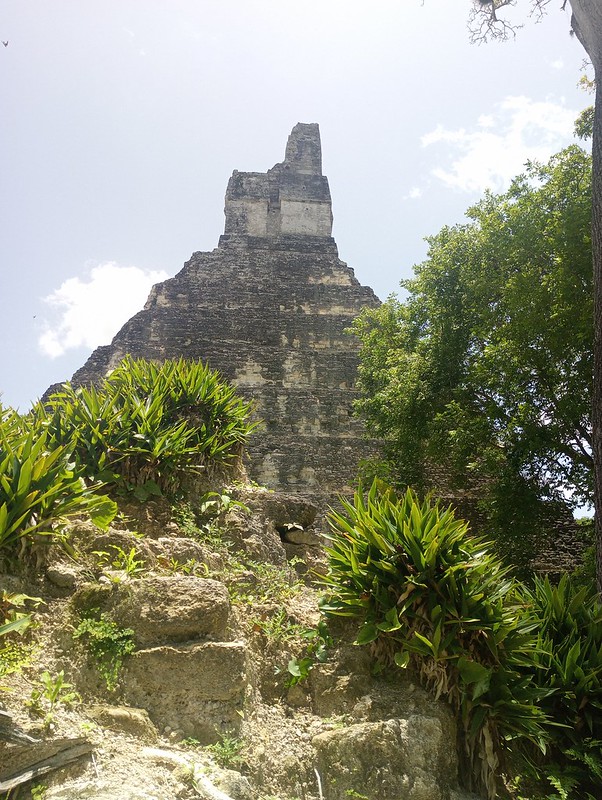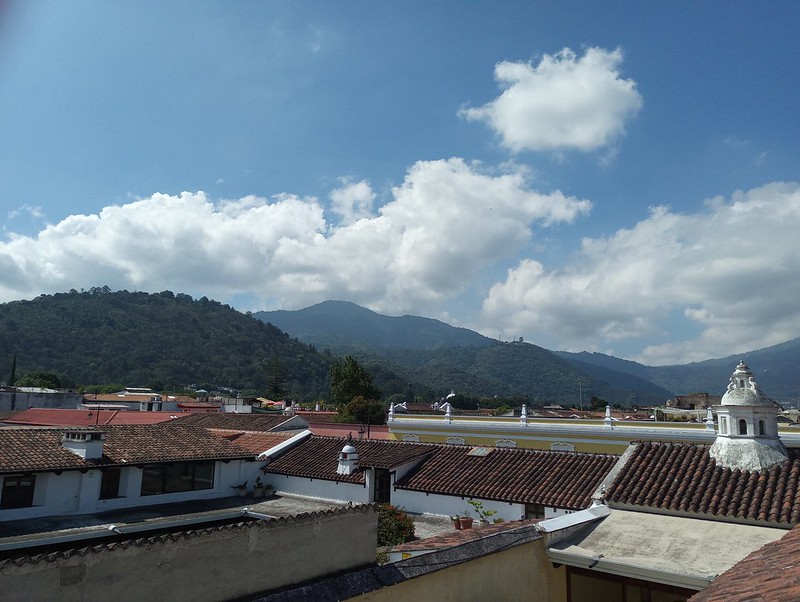My time in Antigua has been enjoyable. I’m trying to keep up with maintaining good street etiquette, confidently speaking Spanish after initially being anxious about it, and enjoying as many coffee shops as I can! As I made my way to Casa Herrera with my homestay friends, I was excited to go to Lake Atitlan: (1) to visit Panajachel, and (2) the textile workshop the program coordinator set-up for us. Guatemala is known for its textiles, and the Lake Atitlan area has a variety of designs, colors and types. One of my non-academic goals for study abroad was to get a shawl. I find them to be beautiful, versatile, and perfect for the Texas winter back home.
Early in the morning, my homestay friends and I walked to Casa Herrera to meet with the rest of our class for the trip. I can’t recall what I ate for breakfast, but I can recall how it wasn’t enough. Once I had enough sunscreen and plenty of bug repellent, I felt ready for the three-hour ride.
On our ride from Guatemala to Antigua, I slept through all of that, so I had no idea what to expect in terms of sightseeing. From what I’ve seen in Antigua, the way that clouds run on the rooftops of homes and the puffs of soot and red glare from the distant volcano at night, there was so much to appreciate and take in. Even with anticipation of what the environment and countryside may look like, I was also curious about the infrastructure of the area, taking note of how space was used on the way to Panajachel.
Throughout the whole trip, I noticed the considerable use of agriculture on the mountains. There was function and beauty to them. Maybe it was the recent rainfall, but the green of these crops was beautiful and vibrant. As great as this was, there is something to be said about what else I’ve seen from the ride to Panajachel.

View of Lake Atitlan from the highway.
In Guatemala, there is a considerable amount of poverty; the kind that manifests with hard working mothers with children setting fruit stands on the sides of highways, the lack of sidewalks for Maya women vendors traveling from their hometowns to the tourist locations, and the need for daughters to go and sell their handmade goods in public spaces. What I saw is the impact of the legacies of U.S. intervention on Latin America and the rise of global warming, and most noticeably the extent of how gendered this violence and damage is to Maya people. The noticeable impact of Maya women bearing the brunt of all of this was difficult to watch.
This context is important, and I bring this up because to ignore this adds to the erasure and exploitation these women go through while tourists take for granted Maya culture and heritage. And so, I try to be aware of how my interaction in these communities, cities, and other forms of spaces impact them. And this is not to say that I have done everything perfectly, I’m just recognizing the privilege I have as a tourist, a college student, and the access to resources that help fund this study abroad.
Once we arrived and settled in Panajachel, we had to walk to our boat, and take it to San Juan La Laguna to visit the textile workshop. The city of Panajachel is a beautiful area, with a massive market and road full of vendors selling many kinds of textiles. To list some that I found to be the most interesting were Maya textile office ties, jean overalls with textiles sewed beautifully on to them, and a lot of Five Nights at Freddie’s crochet figures.
As soon as we got to the boats, the water was beautiful and so alive with movement. To my chagrin (and I’m assuming to most of my classmates), that movement made the boat ride from Panajachel to San Juan a very choppy ride — one in which I kept getting hit in the face with water. Nevertheless, I was excited for the cotton weaving demonstration. I knew nothing much about the co-op, but I was looking forward to learning more about the process of organic cotton becoming the textiles Guatemala is known for.

Boats at the Panajachel public dock.

A choppy boat ride across the lake.

Inside our boat while crossing the lake.
After the boat ride and the uphill journey to the co-op, my class and I were greeted with this great variety of textiles, colors, and jewelry. All of it was beautiful. Once we were in the demonstration room, the presenter readied her materials: raw cotton, the dye, the tools needed for stringing, stretching, weaving and measuring. In what was so effortless for her, perfected skills from a young age, was so difficult for some of my friends who participated – save for one person (she had the right trick to it). The way the presenter spun a spindle with one hand while instinctively pulling from the cotton fluff in the other was mesmerizing to see. This was one step of many in textile making. Throughout the workshop, we were shown the variety of cotton, the kinds of natural pigments used for the dyes, the history of the co-op and its mission to better serve the women who rely on it for their income, and the use of a backstrap loom. There was so much information to process, but it was all so fascinating to learn.
After the demonstration, we were invited to browse around and see if we wanted to purchase anything. There was so much to browse through and see, but I had one objective in mind: buy a shawl! Once I got to the large scarf section of the co-op, there was so many options and colors to choose from. Each scarf was different with individual patterns and colors, all a reflection of the vision the scarf maker had when creating them. After fishing for some opinions and thoughts, I settled on a black scarf with gray accents.
It took four weeks to make, and it was dyed with charcoal for black and eucalyptus for gray-hued blue. The information is on the tag of the scarf, and it’s a reminder of how much time this process takes and explains why it’s priced the way it is. The women who are part of the co-op and make the goods the co-op sells put in so much effort for the textiles. Fortunately, the co-op pays them immediately once they bring their project to them (some pay the weavers only once someone buys the scarves).
After the purchase, I felt happy. I felt happy to have bought this for myself and for my use, while also knowing more about the process for what I purchased.

Enjoying the beautiful surroundings of Lake Atitlan.























